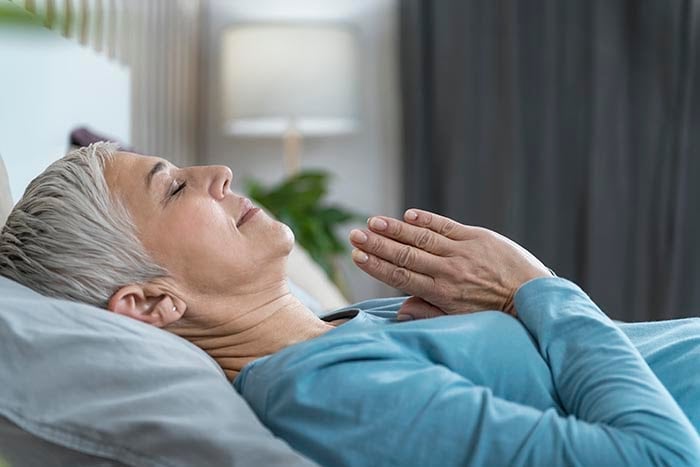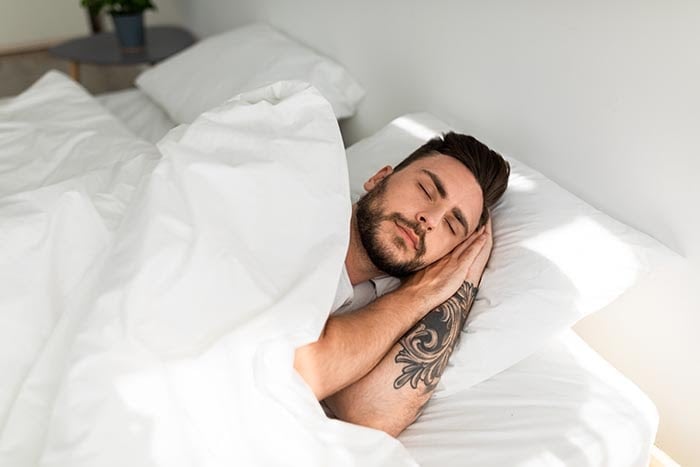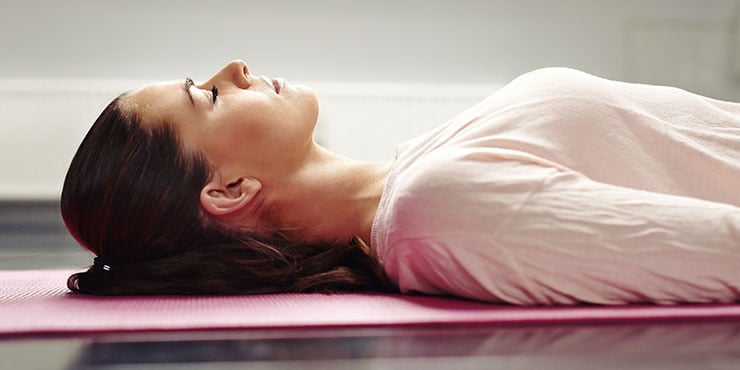
Table of Contents
Do you fear the nighttime because you cannot seem to fall asleep or stay asleep? Deep sleep meditation could be the solution.
Key Takeaways
- Sleep Meditation Practice: Regular practice of sleep meditation techniques like mindfulness, body scan, and breathing meditation can help ease the mind into a state conducive to sleep, promoting relaxation and reducing stress.
- Restful Sleep and Restorative Sleep: Engaging in meditation before bed can improve sleep quality, leading to a more restful and restorative night’s sleep by reducing interruptions and enhancing sleep hygiene.
- Asleep Meditation and Better Sleep Habits: Incorporating asleep meditation practices can help establish better sleep habits, such as consistent bedtimes and creating a calming pre-sleep routine, which are essential for long-term sleep improvement.
- Emotional Balance and Restful Night: Meditation aids in achieving emotional balance, which helps in processing emotions and reducing nighttime anxiety, leading to a more restful night.
- Sleep Aids: Meditation acts as a natural sleep aid, helping to lower stress hormones, enhance focus, and promote a sense of calm and well-being, which are critical for achieving restful and high-quality sleep.
Guided Meditation for Sleep

If you struggle with sleep, you may find yourself staying up late, watching television or browsing on your phone in bed, and feeling generally anxious for the morning to arrive.
These are common characteristics in those who cannot sleep well and those that suffer from poor sleep patterns. In fact, some people go for years avoiding sleep in these ways.
Eventually, everyone gets to sleep — even only for a few hours a night. The problem is that poor sleeping habits (the inevitable small amount of sleep that many people live off on regularly) can have ramifications in your daily life. Inadequate sleep can cause various health issues, both physical and mental. Even if you lead a healthy lifestyle, eat well and exercise regularly, your life and well-being will suffer if you do not get enough quality sleep, keeping healthy sleep hygiene.
So, what can people do to sleep better and improve their sleep cycles? As it turns out, there is a clear answer, and it is not a sleep aid such as a pill, an expensive mattress or a type of new-fangled therapy.
It's the tried and true, the ever-beneficial practice of meditation.
What Exactly is Guided Meditation or Sleep Meditation?
As the title says, guided meditation is when you are being guided through the sleep meditation process. Guided sleep meditation is a beneficial tool for individuals who aim for improved sleep, quality, and quantity. Guided meditations are based on the individual being instructed through the different processes through one-on-one interaction, video call, video and/or audio recording or an application. The goal of guided sleep meditation is to provide better quality sleep for the practitioner. Besides listening to the instructor, it is highly suggested to play some background music, i.e., sleep music, soothing sounds, to help set the mood and improve sleep. Be prepared for what is referred to as a body scan.
But how Does Meditation Help you Sleep?
Here are four specific ways that practicing meditation can help you sleep better and improve your sleep quality.
It Calms the Mind
One of the ways that deep sleep meditation prepares you for a long night of deep sleep is by calming the mind, which is often excessively active from the day. In Buddhism, a highly active mind is called a "monkey mind." The mind behaves like a monkey who incessantly jumps from branch to branch, never staying in one calm place.
While you are at work or school during the day, a monkey mind can be an inevitable part of managing the many areas of your life because it can produce a large amount of anxiety that is pent up over time. The fight or flight response can also contribute to this anxiety.
The fight or flight response is a natural response to serious threats to your safety and well-being (such as tensing up and/or running if you were to encounter a bear in the woods). But when it occurs in reaction to minor stressors, such as social encounters on the weekends or work-related tasks, this means you're becoming over-anxious, negatively impacting your mental health.
To calm the monkey mind and the fight or flight response, meditation helps practitioners focus on just one thing at a time — a highly useful skill in all areas of life. A recent study from the Journal, Behaviour Research and Therapy found that focused attention increased with simple meditation practice. In addition, negative intrusive thoughts decreased, and acceptance and attention increased.
One of the best ways to use meditation to calm the mind is with a guided meditation for sleep. Specifically, guided meditation for sleep can be carried out with help from a meditation instructor. Whether in a class or at home, an individual meditation coach can lead you to practice calming meditation for sleep tailored to your unique needs.
You might also ask your yoga or meditation instructor about Yoga Nidra; a practice meant to induce total relaxation and calmness, putting you on the edge of sleep (and in some cases, lulling you completely to sleep).
It Calms the Body
One of the main reasons meditation helps sleep is that it accelerates the same physiological effects in the early stages of sleep. In other words, when you are in a meditation class and you feel like taking a nap afterward, that is not surprising! Both practices facilitate sleep. Therefore, if you want to sleep better, meditation is the perfect practice to do before bedtime.
Meditation teachings can calm your physical nerves and listen to the beating of your own heart. In fact, recent studies have found that blood pressure reduces during and after meditation practice.
You will also notice that physical tension is released from the body during sleep meditation. One of the ways to accelerate this tension release is to do a body scan, which will be explained below. This involves starting at the top of the head or the ends of the toes, and working your way along with a conscious scan of your entire body, looking for areas that have tension, and mindfully noting the position and status of each body part.
In one version of the body scan, each body part is intentionally tightened and tensed for a moment, only to be immediately relaxed and released. Even if you do not combine this type of body scan with calming meditation for sleep, it can be an advantageous stress management technique.
It Increases Your Focus
Disturbing thoughts, difficult emotions and persistent worries often keep people from falling and staying asleep. On the other hand, those who meditate regularly can focus better and do not get distracted by troubling thoughts as easily. In an extensive longitudinal study released in Springer's Journal of Cognitive Enhancement, it was found that a consistent meditation practice can lead to significant improvements in sustained attention and focus.
This is due, in large part, to meditation's focus on mindfulness.
Mindfulness practice ensures that practitioners focus on the present moment — not the past or the future. This is good because you are likely constantly focusing on the past and the future, whether you realize it or not. Whether you are worried about what will happen tomorrow at school or work, or dwelling on that silly thing you said at the party last weekend. These ruminations are probably one of the largest sources of your worries and daily stressors and anxieties.
But mindfulness practice — inherent in any meditation routine — puts emphasis on the present, thereby omitting any opportunities to dwell and ruminate on pesky and useless anxieties that would generally keep you up at night, interfering with your sleep cycle.
It Increases Your Melatonin Levels
If you have ever taken melatonin to help you fall asleep, you know that it actually works. Melatonin is a naturally-produced hormone that occurs in the brain right before sleep.
You do not have to take a pill of melatonin, though. You can help your body produce more by simply meditating. A recent study conducted by Australian scientists concluded that meditation practice will instigate melatonin production:
"Experienced meditators practicing either TM-Sidhi or another internationally well-known form of yoga showed significantly higher plasma melatonin levels in the period immediately following meditation compared with the same period at the same time on a control night."
What exactly is mindful body scanning?
The instructor will perform body scanning or body scan during guided sleep meditations. But what is a body scan?
We would refer to body scan meditation as mindfulness meditation, promoting awareness of one's physical body. Using physical sensation and visualization helps the user anchor to the root of the mind in the user's body and keeps them in the present moment. This is particularly used during guided meditation and yoga sessions. An excellent example of this is Yoga Nidra to get a night of good sleep.
The use of a body scan is not necessarily all instructors will do, but it is a powerful tool for the instructors guiding the practitioner to connect with their body. By performing this, the practitioner will sense an immediate effect of tension release in affected areas, one of the best-guided meditation tools available. This is why a body scan is used for rest to treat insomnia.
Is it dangerous? No, it is not.
Other Benefits of Guided Meditation
Apart from the benefits mentioned above, there are numerous others to gain by practising this type of meditation. Listing all the benefits would take forever. As such, we have limited our list to some of the top-level benefits you could expect:
- Reduced stress
- Less pain
- Treat insomnia and sleep deprivation
- Relaxation
- Lose weight
- Improve medical condition
- Make falling asleep easier
- Better quality sleep
- Less worry about things one can't control
Try Meditation for Better Sleep Tonight

Want to sleep better as soon as tonight? Here is a short meditation practice to try this evening, right before you head to bed.
Step 1: Set the scene
While this is not necessarily a step associated with meditation, it can be useful to facilitate better sleep regularly.
To set the scene for a good night's sleep, start by dimming the lights in your bedroom. Make sure that all screens and technology are put away. If necessary, set your alarm beforehand. Put on your pajamas (make sure they are comfortable for the duration of the night). Ensure you have clean sheets on your bed.
At this point, you might consider spraying a calming room scent in the air or dabbing a few drops of essential oils on your pillow. Scents such as chamomile and lavender are good for promoting sleep. If you like to sleep with background noise, start a stream of white noise or water or wind sounds at a low level.
Now, climb onto the bed.
Step 2: Position yourself for meditation and a good night's sleep
To meditate in bed, lay on your back with your head on your pillow and your hands at your sides. Position your body, neck and head in a neutral and relaxed position. You should not feel any tension or stress in your body.
To ensure this, do a quick body scan, starting at the very top of your head and working your way down your body to the tips of your toes. Make any necessary adjustments, including moving the covers so that they are over your body in the same way that you would normally sleep with them.
Step 3: Take three deep breaths
Start by taking three deep breaths. Remember that these should come from the base of your lungs. Start by inhaling and bringing in a full breath of air, feeling your stomach rise as you do so. Count slowly to five during your inhale.
For a brief moment, hold your breath before exhaling to a count of five as well. Repeat this breathing exercise two more times.
Step 4: Begin your meditation visualization.
For a beginner's meditation, we will do a short visualization.
Gently close your eyes. Breathe slowly but normally, remember to take the air from the very bottom of your lungs instead of breathing shallowly with your shoulders.
Imagine that you are lying on the soft grass in a cozy clearing in a wood. All around you, fresh trees rustle in the light wind. Wildflowers grow near your feet and all around you. You hear the song of birds and the distant trickling of a mountain stream. The temperature is perfect. You are in the shade, but you can feel the warmth of the sun and the cooling sensation of a woodsy-scented breeze.
Step 5: Speak a mantra in your mind.
Now, take control of your breath once more. There is no need to continue a long, drawn-out, deep breathing routine. Instead, you will be concentrating on the in-breath and the out-breath and repeating a mantra with each inhale and exhale. You should move slowly in your breathing, but not too slowly. It should feel comfortable and relaxed.
Keep your cozy spot in the wood in mind. You are still there.
Now, while you take your next in-breath, say these words in your mind: "Breathing in peace and calm."
As you breathe out, say these words in your mind: "Breathing out stress and tension."
Repeat this mantra as you continue this deep breathing technique at your own pace, and visualize your spot in the woods.
Ideally, you will drift off to sleep while doing this meditation. However, remember that it is okay if you fail to fall asleep when practicing this meditation for the first time. You can try again. By doing this meditation at night before bed for several nights, you will teach your body and mind to relax and focus on calming physical and mental sensations — all of which are necessary to facilitate deeper, better, faster sleep.
References
https://jamanetwork.com/journals/jamainternalmedicine/fullarticle/2110998
https://www.sciencedirect.com/science/article/pii/S0005796717300190
http://sitn.hms.harvard.edu/flash/2009/issue61/
https://link.springer.com/article/10.1007/s41465-018-0068-1#Tab1
https://www.ncbi.nlm.nih.gov/pmc/articles/PMC3328970/
Tell us how we can help you sleep better. Speak with an Anahana Wellness Advisor and connect with your own personal meditation coach today.
Disclaimer
The contents of this article are provided for informational purposes only and are not intended to substitute for professional medical advice, diagnosis, or treatment. It is always recommended to consult with a qualified healthcare provider before making any health-related changes or if you have any questions or concerns about your health. Anahana is not liable for any errors, omissions, or consequences that may occur from using the information provided.

By: Clint Johnson
Clint is the driving force and founder of Anahana. Clint teaches Yoga, Pilates, mindful breathing, and meditation, catering to a global community of students and teachers.

